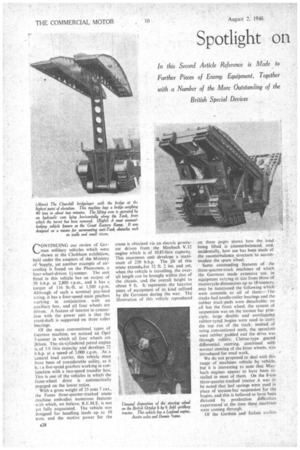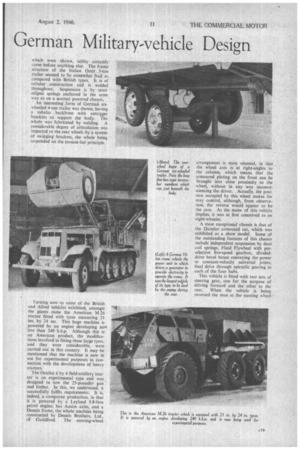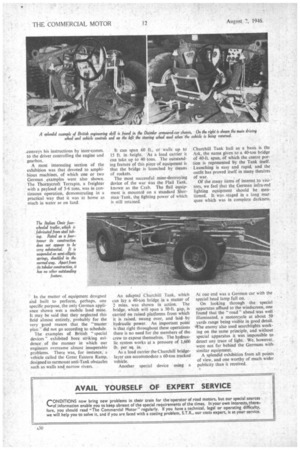Spotlight on
Page 30

Page 31

Page 32

If you've noticed an error in this article please click here to report it so we can fix it.
German Military-vehicle Design
CONTINUING our review of German military vehicles which were shown at the Chobham exhibition, held under the auspices of the Ministry of Supply, yet another example of aircooling is found on the Phanomen, a four-wheel-driven 1 Homer. The unit fitted in this vehicle has an output of 50 b.h.p. at 2,800 roan., and it has a torque of 116 lb.-ft. at 1,500 r.p.m. Although of such a nominal pay-load rating, it has a four-speed main gearbox working in conjunction with an auxiliary box, and all four wheels arc driven. A feature of interest in connection with the power unit is that the crankshaft is supported on three roller bearings.
Of the more conventional types of' German machine, we noticed an Opel 3-tonner in which all four wheels are driven. The. six-cylindered petrol engine
of 3.6 litre capacity and develops 72 b.h.p. at a speedof 3,000 r.p.m. As a Leneral load carrier, this vehicle must have been of considerable utility, as it h; a five-speed gearbox working in conjunction with a two-speed transfer box: This is one of the vehicles in which the front-wheel drive is automatically engaged on the lower ratios.
With a gross weight of 25 tons 7 cwt., the Famo three-quarter-tracked crane machine embodies numerous features with which, we believe. R.E.M.E. is not yet fully acquainted. The vehicle was designed for handling loads up to 10 tons, and the motive power for the
crane is obtained via an electric generator driven from the Maybach V.12 engine which is of 10.831litre capacity. This enormous unit develops a maximum of 230 b.h.p. The jib of this crane extends.for 32 ft. 2 ins, and yet, when the vehicle is travelling, the overall length can be brought within that of the chassis, and the overall height to about 9 ft. It represents the heaviest piece of equipment of its kind utilized by the Germans during the war. The illustration of this vehicle reproduced
on these pages shows how the load being lifted is counterbalanced, and. incidentally, how use has been made of the counterbalance, structure to accommodate the spare wheel.
Some outstanding features of he three-quarter-track machines of which the Germans made extensive use, in equipment varying in size from those of motorcycle dimensions up to 18-tonners. may be mentioned the following which were common to all of them:--1 he tracks had needle-roller bearing.s and the rubber track-pads were detachable; on all but the front wheel, the system of suspension was on the torsion bar principle: large double and overlapping rubber-tyred bogies were used to carry the top run of the track: instead of using conventional teeth, the sprockets were rubber padded and the drive was through rollers; Cletrac-type geared differential steering, combined with normal steering of the front wheels, was introduced for road work.
We do not proposed to deal with thk range of machines vehicle by vehicle, but it is interesting to note that Maybach engines appear to have been installed in Most of them. On the 8-ton three-quarter-tracked tractor it was to be noted that leaf springs were used in place of torsion-bar suspension for the bogies, and this is believed to have beers dictated by production difficulties experienced at the time these machines were coming through.
Of the German and Italian trailers which were shown, utility certainly came before anything else. The frame structure of the Italian Omir 5-ton trailer seemed to be somewhat frail as compared with British types. It is of tubular construction and is welded throughout. Suspension is by semielliptic springs anchored in the same way as on a normal powered chassis.
An interesting form of Germaii sixwheeled 4-ton trailer was shown, having a tubular backbone with outrigger brackets to support the body. The whole was fabricated by welding. A considerable degree of articulation was imparted to the rear wheels by a system of swinging brackets, the whole being suspended on the torsion-bar principle.
Turning now to some of the British and Allied vehicles exhibited, amongst the giants came the American M.26 tractor fitted with tyres measuring 21 ins. by 24 ins. This huge machine is powered by an engine developing no* less than 240 b.h.p. Although this is an American product, the modifications involved in fitting these large tyres, and they were considerable, were carried out in this country. It may be mentioned that the machine is now in use for experimental purposes in connection with the development of heavy ractors.
The Octolat 6 by 6 field-artillery tractor is an experimental type and was designed to tow the 25-pounder gun and limber. In this, we understand, it successfully fulfils requirements. It is, indeed, a composite production, in that it is powered by a Leyland 9.8-litre petrol engine, has Austin axles, and a Dennis frame, the whole machine being constructed by Dennis Brothers, Ltd., of Guildford. The steering-wheel arrangement is most unusual, in that the wheel axis is at right-angles to the column, which means that the armoured plating on the front can be brought into close proximity to the wheel, without in any way inconveniencing the driver. Actually, the position occupied by this wheel makes for easy control, although, from observation, the reverse would appear to be the case. As the name of this vehicle implies, it was at first conceived as an eight-wheeler.
A most exceptional chassis is that of the Daimler armoured car, which was exhibited as a show model. Some of the outstanding features of this chassis include independent suspension by dual coil springs; Fluid Flywheel with preselective five-speed gearbox; divideddrive bevel boxes conveying the power to constant-velocity universal joints; final drive through epicyclic gearing in each of the four hubs.
This vehicle, is fitted with two sets of steering gear, one for the purpose of driving forward and the other to the rear. When the vehicle is being reversed the man at the steering wheel .conveys his instructions by inter-comm. to the driver controlling the engine and gearbox.
A most interesting section of the exhibition was that devoted to amphibious machines, of which one or two German examples were also shown. The Thomycroft Terrapin, a freighter with a payload of 5-6 tons, was in continuous operation, demonstrating in a practical way that it was at home as much in water as on land.
In the matter of equipment designed and built to perform, perhaps, one specific purpose, the only German appliance shown was a mobile land mine. It may be said that they neglected this field almost entirely, probably for the very good reason that the "master plan " did not go according to schedule.
The examples of British "special devices" exhibited bore striking evidence of the manner in which our engineers overcame almost insuperable problems. There was, for instance, a vehicle called the Great Eastern Ramp. designed to surmount anti-Tank obstacles such as walls and narrow rivers.
It can span 60 ft., or walls up to 15 ft. in height. As a load carrier it can take up to 40 tons. The outstanding feature of this piece of equipment is that the bridge is launched by means of rockets.
The most successful mine-destroying device of the war was the Flail Tank. known as the Crab. The flail equipment is mounted on a standard Sherman Tank, the fighting power of which is still retained.
An adapted Churchill Tank, which can lay a 40-ton bridge in a matter of 2 mins. was shown in action. The bridge, which will span a 30-ft. gap, is carried on raised platforms from which it is raised, swung over, and laid by hydraulic power. An important point is that right throughout these operations there is no need for the members of the crew to expose themselves. The hydraulic system works at a pressure of 1,600 lb. per sq. in.
As a load carrier the Churchill bridgelayer can accommodate a 60-ton tracked vehicle.
Another special device using a Churchill Tank hull as a basis is the Ark, the name given to a 40-ton bridge of 40-ft. span, Of which the centre portion is represented by the Tank itself. Launching is easy and rapid, and the outfit has proved itself in many theatres of war.
Of the many items of interest to visi' tors, we feel that the German infra-red lighting equipment should be mentioned. It was. staged in a long marquee which was in complete darkness.
At one end was a German car with the special head lamp full on.
On looking through the special apparatus affixed to the windscreen, one found that the "road" ahead was welt illuminated, a motorcycle at about 50 yards range being visible in good detail. dl he enemy also used searchlights working on the same principle, and without special apparatus it was impossible to detect any trace of light. We, however. were not far behind the Germans with similar equipment.
A splendid exhibition from all points of view, and one worthy of much wider publicity than it received.




































































